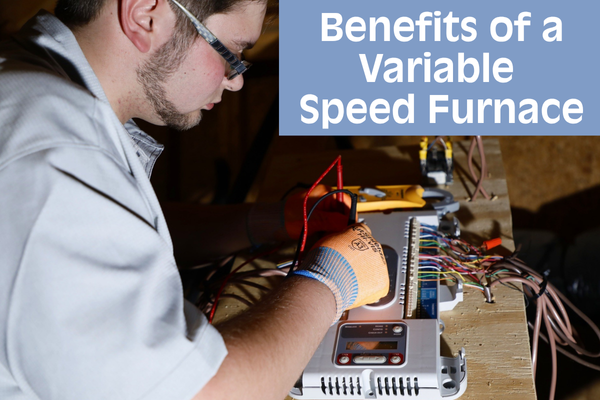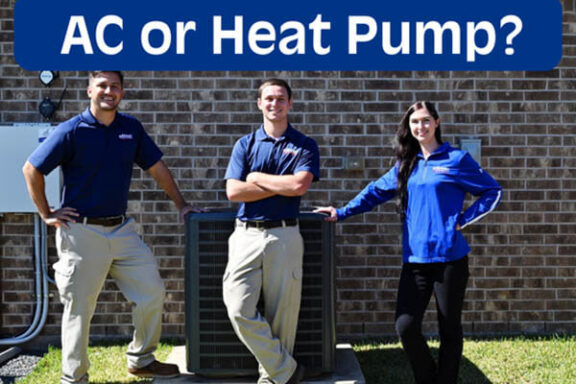Learn about the Benefits of a Variable-Speed Furnace
Heating Systems HVAC Technology & Innovations

A Guide to Variable-Speed Furnaces and How They Work
Cool weather seasons bring a wide range of weather conditions and lower temperatures that make a reliable HVAC system an absolute must. If you have a traditional single-speed furnace, it might be time for an upgrade that will improve your home’s energy efficiency, lower utility bills, and create a more comfortable and consistent indoor temperature. You can get all those benefits and more with a variable-speed furnace..
Here, we’ll explore more about variable-speed furnaces, learn how they work, what they can do to improve your home during the colder months, and how you can choose a heating system that meetings your needs while using less energy.
What is a Variable-Speed Furnace?
A variable-speed furnace can run at any speed within a set range, usually between 30 to 100 percent of its capacity. The microprocessor that controls the motor can select precisely the most energy-efficient speed for any heating or cooling demand.
Any type of HVAC system can have variable-speed functionality, including electric or gas furnaces and heat pumps. The blower motor is the key that makes a furnace variable in speed. When this blower motor is adjustable and can operate at different capacities, the furnace in question is then considered variable-speed.
Homeowners often find that installing a variable-speed furnace gives them greater control over indoor temperatures and results in greater consistency and comfort.
Variable-Speed Furnace vs. Single-Stage Furnace
Single-speed furnaces were the standard for a long time, and they’re still very common, especially in older homes with original HVAC systems. A single-stage furnace has only two functions: ON and OFF. When the furnace is running, it’s operating at full capacity. Otherwise, it isn’t running at all. While a single-speed furnace can certainly get the job done, it’s the least energy-efficient, and doesn’t give the homeowner much control. Indoor temperatures tend to be at extremes, and because it’s constantly running at full capacity, it’s also more likely to blow contaminants into the air and reduce indoor air quality.
Is a Variable-Speed Furnace the Same as a Two-Stage Furnace?
No, a variable-speed furnace is not the same as a two-stage furnace. Two-stage furnaces are an upgrade over single-speed furnaces, but the blower fan motors in older, mid-efficiency furnaces still have only two speed settings: high and low. Most of the time, the lower, more energy-efficient setting is enough to keep a home comfortable, so the furnace kicks into high only when it needs to meet higher-than-normal heating or cooling demands.
However, there may be times when outdoor temperatures are fluctuating dramatically, and that will require you to have more control over your indoor temperature settings for maximum comfort. In climates where varying temperatures and weather conditions are the norm, variable-speed furnaces provide a reliable and energy-saving solution.
Components of a Variable-Speed Furnace
In most ways, a variable-speed furnace works in much the same way as single-speed or two-stage furnaces, with a few key differences. You can expect to find the following components in a variable-speed furnace:
ECM
The electronically commutated motor (ECM) is the defining feature of a variable-speed furnace. The ECM is what allows the speed to be adjusted to suit your individual heating needs. This variable-speed blower motor kicks into gear when your thermostat triggers it to start, and optimizes airflow while maintaining a consistent and comfortable temperature.
Heat Exchanger
The heat exchanger transfers the heat generated in the combustion process inside a variable-speed gas furnace into the circulated air. In an electric furnace, heating coils or elements create the heat. Heat pumps use heat exchangers as well to extract heat from the outside environment and then push it inside.
Air Handler
The air handler refers to a significant portion of your variable-speed furnace, which includes the blower motor, evaporator coil, and in some cases, heating elements. When all parts of the air handler are working together, this is what distributes warmed air throughout your home.
Controller
A variable-speed furnace controller is pre-programmed to automatically adjust the speed of the furnace to meet demand, based on the outdoor temperature and your preferred indoor heat setting.
Modulating Gas Valve
In gas furnaces, the modulating gas valve is another crucial component of the variable-speed furnace that allows it to adjust its capacity. The modulating gas valve changes the gas flow inside the furnace so that it only utilizes enough to generate the desired level of heating.
Ductwork
Ducts are pipes or channels that run throughout your home and funnel heated or conditioned air into your indoor spaces. They can run above ceilings or below floors, and push the air out through registers.
Benefits of a Variable-Speed Furnace
There are many advantages to having a variable-speed furnace. If you already have a two-stage furnace, it may not make sense to upgrade until it’s getting close to the end of its lifespan, but if you have a single-speed traditional furnace, you might find that the benefits outweigh the cost of replacement. Benefits of a variable-speed furnace include:
Lower Energy Bills
Thanks to its ability to fine tune its speed for maximum energy efficiency, a variable-speed motor provides optimal energy savings no matter how much heat or cooling your home needs at any given moment. A variable-speed furnace can meet around 80 percent of the average home’s needs while running at lower speeds, which results in overall lower energy bills.
Greater Energy Efficiency
A conventional furnace pushes out a large amount of air quickly before shutting off, often causing uncomfortable temperature fluctuations. A variable-speed furnace runs for longer cycles at lower speeds. This means it heats your home gently, preventing temperature swings and eliminating cold and hot spots. In summer, the motor’s longer cycles give your A/C more time to reduce humidity, improving your comfort.
Improved Indoor Air Quality
Longer cycles mean your home’s air is drawn through the furnace air filter more often. This results in better air filtration and higher indoor air quality. This can dramatically reduce the amount of contaminants that infiltrate your indoor air, which can lessen the effects of seasonal allergies, reduce risk of respiratory illness, and contribute to a healthier and cleaner home.
Noise Reduction
A motor running at a lower speed has a quieter operation, so you can enjoy a calmer, noise-free home. Single-speed furnaces can be loud, and since they’re always operating at the same speed, the noise can become a major inconvenience, especially for people who work from home or have young children. As an added benefit, lower operational speeds also place less wear and tear on the motor, helping it last longer.
Targeted Temperature Control
The controller inside a variable-speed furnace allows it to be extremely sensitive to the temperature inside the home, so it can better make adjustments to keep the environment at the exact desired temperature. Even when the outside temperature is swinging wildly, the indoor temperature remains stable, so it’s a great choice for locations with uncertain or frequently changing climates. It can also compensate for issues like debris or obstacles around a vent, so it pushes air where it needs to go to maintain the temperature.
Increased Home Comfort
All of this adds up to increased comfort for the homeowner, and all the rest of the home’s residents. A cleaner home at an ideal temperature is appreciated by everyone — especially when the utility bills get delivered.
Ready to Get More Control Over Your Home Comfort?
Interested in enjoying the benefits of a high-efficiency, variable-speed furnace in your home? Find out how getting different speeds from your furnace can mean lower energy bills and a more enjoyable home environment. If it’s time for a new furnace, get in touch with us at Airtron Heating & Air Conditioning for guidance in selecting the right speed furnace for your family’s needs.


